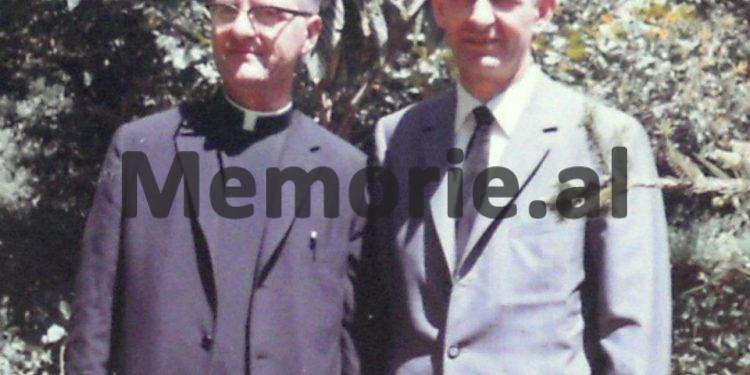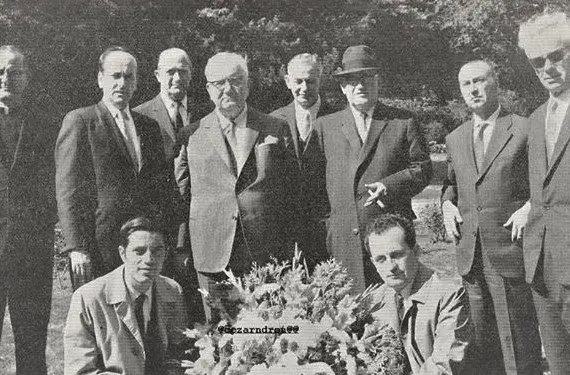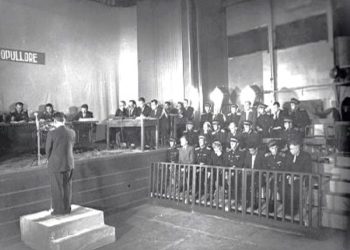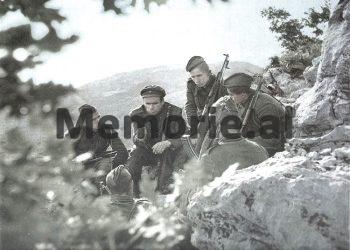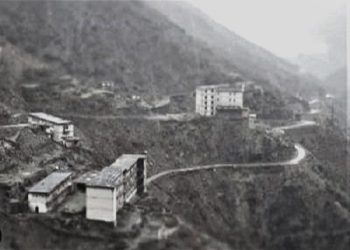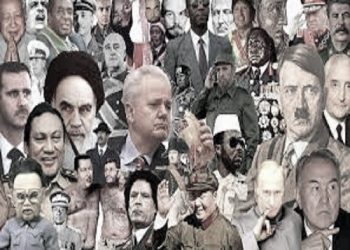From Ndue Dedaj
Memorie.al / Legend…?! No, it’s not like that at all, but an unusual story of the 50s, of the last century. A political story, where her character is not a politician, but a religious missionary. He himself would not want a story beyond the mission anyway, but this is the nature of totalitarian regimes, so that every individual from every field of life or even the divine sees it politically. The first ten years after the Second World War must have been among the most difficult for Albanians. The war that had driven out the invaders had at the same time established the atheist communist regime, for which there was nothing acceptable from the clergy and religion.
Thus, Dom Zef Oroshi (1912-1979), Oroshi, born in the small village of Kaftalle (Mirdita), graduated in Rome in 1940, in theology and philosophy and was ordained a priest for the Abbey of Mirdita, could not have expected a better fate. better than his predecessors, who; either they were executed as “enemies of the Party”, or they were killed in prison and those who remained, the next punishment awaited them. It was just a matter of time, when the “Sword of Damocles” would fall on him.
And the day comes for the priest of the bajrak of Dibrri, a sad winter day, with an incredible event. It was January 1952. (Through articles, encounters and 1951). The State Security also had its eye on Dom Zef Çok (Oroshit), parish priest of Ungrejt, Kashnjet locality; descendant of Dom Ndue Cubi, Dom Prend Ungrejt, Dom Ndre Simon, Dom Prend Brunga, Dom Pjetër Melgushi, Dom Nikollë Laska, Dom Prend Qafalija, Dom Nikollë Lulit, etc. In the 1920s, of the 20th century, Hungary had for some time been the center of the Subprefecture of Mirdita. It was cold and the chestnut forest above the church was rustling along with the people.
The priest was leading the Sunday mass at the “Saint Mary Magdalene” church, where there were also children’s baptisms. A deathly silence hung like a gray cloud over the Vela Mountain, down to the Good Field, the Bazaar Pass and the Butmi hill, where the church and the castle stood stoically. Mali i Krestha, like a stone curtain, separated the eastern highlands from the plain of Zadrima and Lezha. The security was the eyes and ears of the regime and it had its own diligent informers, who did not hesitate to report anything related to the movements of the fugitives, the “reaction gangs”, as they were called in the official jargon.
But he had his faithful and the priest, who did not want to take any risks, challenging the repressive Enverist-Kocist state. The people loved their religion and their noble priest, who had gained great respect and authority there. And here one of them manages to signal the priest inside the mass, where there were also informants from the Security, who were waiting for the end of the mass, to see him kneeling before the altar, the crucifixion of Oroshi, like Christ on the cross. It seemed like everything was going according to the script. Upon hearing the words of the vicar’s assistant:
“Mass is over, go in peace”, the people of the Internal Affairs Branch of Lezha, would appear in front of the public and throw away the handcuffs; “enemy of the people” Dom Zef Oroshi. “Understand us, people, we have nothing to do with the church, but this priest has collaborated with the reactionaries of the mountain and our enemies across the borders.”
Maybe it wouldn’t happen like this, but a little differently, in order not to “rape” the cult object in the eyes of the people, the Security forces would not make the arrest in the church, but would handcuff the heretical priest as soon as he came out of the church. church and leave for the cell. The job was for people to see the “spectacle” and for the event to be passed on by word of mouth: “Hey, they arrested Dom Zef Çoku! Yes, yes, as an enemy of popular power…”!
Everything was carefully calculated. In Tirana, a telegram with a number was expected from moment to moment, that; in Kashnjet (Hungary), the work was done. The man in black had his suit cut off. It was possible that the prime minister himself was waiting for the news. Only sudden death could stop this state evil, on the man of faith, among the people.
However, as it was said, one of his followers informed the priest that he would be arrested after the mass! The priest did not spoil the blood. He calmly continued the mass ritual. He calculated the time, it was almost not enough to escape. Even more so, that it was not in the style of the man of fees, rifles and adventurism of kacak.
Then, how could a priest run away from mass?! The church yard was full of people. Both inside and outside the church. And among them a dozen of the secret police. But his loyalists had also thought of how to escape the priest, seriously challenging the authority of the state and the officials of the Internal Affairs. In the people, there was always a genius who knew how to build a bridge, where it seemed impossible.
…Here’s how the event unfolded “behind the scenes”, in those few minutes, with speed and secrecy.
The priest’s sister, Lukja, takes a pair of women’s clothes from the cell and takes them to the priest’s dressing room, which was an annex of the church, with an exit from the side of the forest. It was the last ten minutes of the mass and Dom Zefi, leaves the holy altar (perhaps leaving some priest or nun, to announce some announcement, related to the catechism or something else outside the mass), goes into his alcove and quickly dresses and quick as a woman and at once, she goes out the back door and disappears into the chestnut forest, crossing a small ravine.
No one paid attention to a “woman” who came out of that door, since the priest had his mother and sister there and could be visited by his family at any time. Who could have thought that that man of God, under that beautiful outfit posing in a sweatshirt, was not a woman, but Dom Zef Oroshi himself, who would never return to that place? The stream of Dibrri would continue to go down in its solitude, while the priest would climb up the ridges stained by winter and the “Cold War”, between capitalism and the socialist camp.
People were waiting for the priest to return to distribute the holy chalice to the faithful and to conclude the mass, but he was being delayed for so long…?! That was all. It had never happened that the priest left the mass without closing it! But this would be a story, one of those that rarely happened, covered with a mythical veil.
As it can be guessed, there was a meeting with the people of the Security and the Tracking Forces, or even the hierarchy of the state. How was it possible?! The earth had swallowed the rebel priest! (It was wrongly written in some publication that the police force in that operation was led by the famous soldier Hodo Habibi, popularly known as “Lieutenant Baba”, but he was sentenced to death on the rope in 1947, for the sadistic crimes he had carried out on the people of Mirdita and Zadrima, at the head of a special punitive battalion.)
Even though it was understood that Dom Zefi had left the rifle for their cheek, someone from the Security people had gone straight to the old mother and had provoked her, where could she find the priest, that she needed him for a religious work? “Besa, mother Dila, I don’t know anything, he was in the church after the mass, he didn’t come to the house”. For the sudden disappearance of the priest, who was nowhere to be found, the legend would quickly spread among the people that; Dom Zefi had taken a detour to Frega and, further to Gjadër, where there was a military aircraft runway, and with the first plane, he had flown to Rome.
This is an addendum, which makes the continuation of the story a bit like an urban legend, when in reality the priest, after having walked up to the Church Neck, would take the side of Molungu, where he had joined the opponents of the regime, who wandered the mountains on the run. This had not been his desire and choice, he had wanted to continue serving the believers, but his fate was written by others, the people with hammer and sickle and the red star on the forehead and on the collars of the military jackets of the Russian cut.
The people of the regime did not want the rhapsodists to sing about the Party’s victories against the “reactionary gangs” and the “treacherous priest”, but neither in this case nor in any other case, the wise rhapsodists, did not speak like this. About Khrushchev, Tito and Johnson, yes, what they didn’t say in their political-patriotic songs, but not about their fugitives, and this is an added value of the people, who did not even accept that the Kren were insulted on their tables. , those outside of politics, he satirized without pain.
The code of Albanian moral resistance also appears here, without which there would be neither resistance against the rulers, nor political, cultural, religious, etc. dissidence.
Dr. Dom Zef Oroshi had followed the path of all the other fugitives, first through the mountains of Mirdita, for several months, then in Yugoslavia, from there to Italy and finally, in America, in 1962. Collaborator from the beginning, with the magazine “Shejzat” by Ernest Koliq and Martin Camaj, with “all kinds of writings”, where according to Professor Karl Gurakuqi; “His rich language stands out”, who when he came to America, would be the director of the “Jeta Catholice Albanian” magazine.
Translator into Albanian of the work “The Four Gospels and Acts of the Apostles”, which he dedicates to his former teacher, Ndre Mjeda, a work also appreciated by the well-known Albanianologist, Zef Valentini. There would also be meetings with Monsignor Fan Nolin, who led the Orthodox Church in America, in the framework of the ecumenical dialogue (inspired by the Second Vatican Council), on the possibility of the union of two sister churches, “from the sacramental and institutional side”. and would be received in the audience by Pope Paul VI, to whom Oroshi would present the translation of the Gospels.
He, together with Dom Rrok Mirdita, in 1973 would wait in New York for Mother Teresa, whom he had met in Italy, since the beginning of the 60s. He also had an extensive correspondence with cultural, missionary and political personalities of the Albanian diaspora. His life was that of an unstoppable hurricane, for the benefit of the Albanians.
Jozef Oroshi, a man of knowledge, missionary, orator, polyglot, publicist, would have once been Abbot of Mirdita, in Orosh, but the apostolic mission had thrown him elsewhere, to build the church of the Albanians of America, as his predecessor had done his, Monsignor Prend Doçi, who had founded the church in Newfoundland. It was surprising how two noble clergymen would have the burden of serving the Church of Rome, on the American continent, with almost a century in between. Zef Oroshi, unifier of Catholics there, becomes the founder of the first Catholic Church of Albanians in America, “Our Lady of Shkodra”, which he led for twenty years, from 1969, until 1989, when he would pass away, in at the age of 77 and at his feet, Monsignor Rrok Mirdita would come.
Oroshi is one of the most active voices of political emigration, for the violation of human rights in Albania and the dictatorship that mercilessly robbed the clergy and the church. He is undoubtedly among the most charismatic characters of the Albanian diaspora, for forty years he lived with Albania and the sad fate of the clergy left here and after he left, constantly denouncing his salvation.
Several times he raised the exile to his feet, becoming a messenger of terror on the Catholic Clergy in Albania, for which the political press here flogged him with the name Zef Oroshin, which was not so much in the practice of the time. For the regime of Tirana, he was a “spoon”, which appeared constantly in bad dreams of the government of Tirana. The Albanian diaspora in America strongly felt his unifying hand in the 1960s and 1980s.
Those who know his life story, cannot but ask where he found all that strength and energy to challenge the communist regime in the most unparalleled way, like in the mountains of the North, full of “Follow-up Forces”, like through Albanian protests in front of the UN headquarters, in the early 70s, when Prime Minister Mehmet Shehu had gone there to give a speech.
Only to unchanged moral principles and patriotism. To the strong character of the typical and unyielding Mirdita, who did not know the power of violence? To the unusual popularity he enjoyed, among the people of his parish and the whole province of Mirdita. Those who got him out of the curfew on that unusual day in January ’52, in Hungary, proved that they were devout believers and that their faith in the new “god”, the Communist Party, was much weaker than that in God.
It could not happen that in Mirdita, a priest was received in the faith. Even the Canon did not allow this. 70 years have passed since his departure and, among the elderly, Dom Zefi is still spoken of with great admiration. Although in Albania, this figure is not well known, it must be said that quite a bit has been written and published about him, monographs and articles, documentaries, etc. have appeared.
The President of the Republic, Bamir Topi, awarded him the high title; “Order Gjergj Kastrioti Skënderbeu”; for his role “as a prominent patriotic cleric and intellectual, who put his activity at the service of preserving and strengthening national values, among all Albanian emigration in the USA, regardless of religion”. He, like all the great prelates, knew how to build the work, both in a parish in the midst of simple mountains, and in the American metropolis, where the population had other social-cultural problems.
Monsignor Rrok Mirdita has spoken more than once about the priestly and intellectual role of Dr. Zef Oroshit, in the affairs of the Albanian community in America, until the reconciliation of blood in their families in Kosovo, Montenegro, etc. Zef Oroshi has the merit of establishing not only the Albanian Church there, but also the cultural and patriotic dialogue between Albanians in America.
And now an epilogue…! Let’s go back to Ungrej-Kashnjet, right after the spectacular escape of Dom Zef Oroshi, that winter of 1952, dressed as a midday woman. It is in the nature of the missionaries to lead mass, in any circumstances they are in, (often even inside the cells), so contemporaries confess that; Dom Zefi would lead mass for Easter of that year, on the mountain of Molung, among the anti-communist resistance fighters, but then in Kosovo, where he would be for a few months during the summer of that year, until the day came, (as writes Klajd Kapinova), that together with three other priests, Father Daniel Gjeçaj OFM, Father Ambroz Martini OFM and Dom Nikolle Kimza (historian), would travel from Trieste to Italy, where Oroshi and Kimza would be generously received at John’s house John Mark in Rome, also a political fugitive like them, since 1944.
As for Dom Zefi’s people in Albania, Sister Luke (Lucien), brothers and relatives, the long ordeal of exiles in Gradishte, Lushnja, etc., would begin, with their entire family and friendly circle being persecuted.
The story of Monsignor Oroshi is treated in a special way in the book of Markus Peters “Confrontations of the history of the Catholic Church in Albania” (1919-1996), which we are referring to because of a handicap from the state, ten months after Oroshi’s escape from Kashnjeti, but not yet from Albania. Around the end of November 1952, two priests, whom the author calls “investigators” (Dushi and Sahatçia) set off towards Ungrej and Kashnjet with a “delicate mission” to find out where Monsignor Oroshi was hiding, but also to propagate in the people and in the church among the believers, against his escape, where during the sermons in the mass, he was asked of them; “the surrender of Dom Zef Oroshi”.
Peters writes: “The believers who went to church could not know that the sermon of that Sunday was ordered by the Minister of the Interior, Mehmet Shehu.” Of the two priests, it was emphasized that; “the escape of Dom Zef Oroshi had left a very bad impression on the government and that he had already been excluded from the Clergy”. But the “November mission” was unsuccessful, as D. Zef Oroshi was “completely free” (Quotes from the book, p.197).
The regime had chosen this language for the lynching and public denigration of Catholic priests, who were resisting the dictatorship with great difficulty. He talked about them on the moral side, where, with the help of the Security collaborators and the agit-prop bosses of the Party Committees, he shamelessly fabricated potentially compromising manuscripts, as some “diaries” say, in which they recorded intimate stories, with women parish, but without publishing any facsimile of these “documents”!
Zef Oroshi, a simple parish priest in Mirdita, in the free world became Monsignor and founder of the Church of the Albanians of America. After him in Hungary, another prominent Albanian priest would serve, but with a completely different fate from him, Dom Simon Jubani, who would make his stay in communist prisons, where he was imprisoned for thirty years, until when the day came and he led the first mass, with the fall of communism, on November 4, 1990, in Shkodër. Memorie.al





